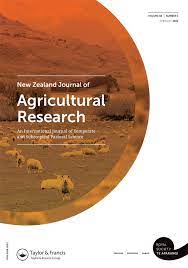View Item
- xmlui.general.dspace_homeCentros e Institutos de InvestigaciónCIAP. Centro de Investigaciones AgropecuariasInstituto de Fisiología y Recursos Genéticos VegetalesArtículos científicosxmlui.ArtifactBrowser.ItemViewer.trail
- DSpace Home
- Centros e Institutos de Investigación
- CIAP. Centro de Investigaciones Agropecuarias
- Instituto de Fisiología y Recursos Genéticos Vegetales
- Artículos científicos
- View Item
Light interception, yield, spring regrowth and quality of Chloris gayana under different defoliation regimes
Abstract
To study the effect of different defoliation regimes on light interception, forage yield, spring regrowth and quality of one of the most expanded species in this region, Chloris gayana, we evaluate combinations of two defoliation frequencies (300 and 500 GDD) and two intensities (1 and 3 green stubble leaves) in a controlled experiment that comprised 1500 GDD during summer and autumn. Defoliation frequency had a greater effect on the evaluated traits than
[ver mas...]
To study the effect of different defoliation regimes on light interception, forage yield, spring regrowth and quality of one of the most expanded species in this region, Chloris gayana, we evaluate combinations of two defoliation frequencies (300 and 500 GDD) and two intensities (1 and 3 green stubble leaves) in a controlled experiment that comprised 1500 GDD during summer and autumn. Defoliation frequency had a greater effect on the evaluated traits than defoliation intensity. Forage yield was lower under the higher (300 GDD) than under the lower (500 GDD) frequency defoliation (6699 vs. 8961 kg DM/ha, respectively), but forage showed higher leaf percentage (69.8 vs. 53.2%) and better nutritional value at 300 GDD (17.4 vs. 15.6%, 64.1 vs. 62.1%, 60.9 vs. 63.2% and 67.7 vs. 62.4% of crude protein, dry matter digestibility, neutral detergent fiber and its digestibility, respectively) than at 500 GDD. Spring tiller density was not affected by any of the defoliation regimes. Better livestock performance could be obtained by grazing at 300 GDD, but considering the whole growing season, more digestible dry matter is likely to be produced under defoliations every 500 GDD than every 300 GDD.
[Cerrar]

Author
Ruolo, Maria Soledad;
Perez, Hector Eduardo;
Rodriguez, Adriana Mabel;
Fuente
New Zealand Journal of Agricultural Research (2022). (Published online: 22 Feb 2022)
Date
2022-02-22
Editorial
Taylor and Francis
ISSN
0028-8233
1175-8775 (online)
1175-8775 (online)
Formato
pdf
Tipo de documento
artículo
Palabras Claves
Derechos de acceso
Restringido
 Excepto donde se diga explicitamente, este item se publica bajo la siguiente descripción: Creative Commons Attribution-NonCommercial-ShareAlike 2.5 Unported (CC BY-NC-SA 2.5)
Excepto donde se diga explicitamente, este item se publica bajo la siguiente descripción: Creative Commons Attribution-NonCommercial-ShareAlike 2.5 Unported (CC BY-NC-SA 2.5)

